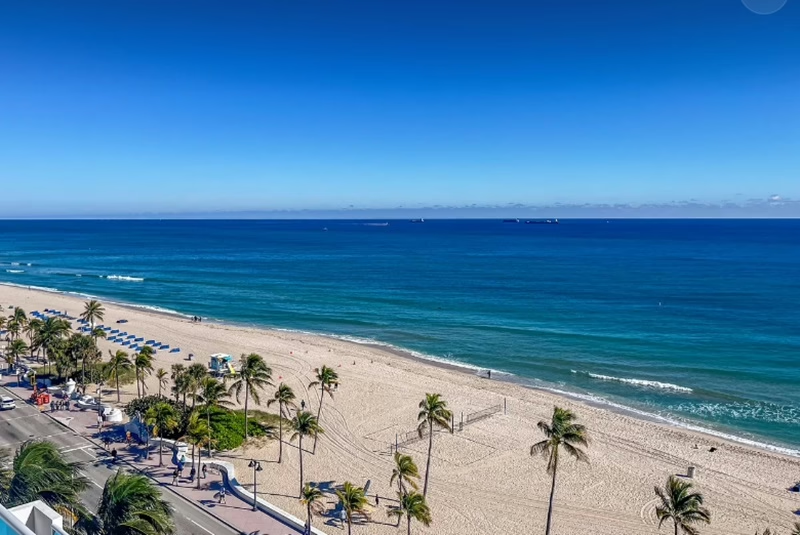Florida is widely known by its nickname “Sunshine State”, and it is not difficult to understand why. With pleasant temperatures almost all year round, sunny days and mild winters, the state is one of the favorite destinations for those who seek to escape the harsh cold and enjoy a more active and outdoor lifestyle.
Florida’s mild and comfortable weather is one of the main advantages of living in the state. In this article, we explore the climate of Florida in detail, highlighting its seasons, regional peculiarities and how to prepare for the state’s weather conditions.

A Tropical and Subtropical Climate
Florida’s climate varies between tropical in the south (in regions such as Miami and Florida Keys) and subtropical in the north (near Jacksonville and Tallahassee). This variation ensures hot and humid summers and incredibly mild winters, providing ideal conditions to enjoy beaches and outdoor activities practically all year round.
Cities like Miami and Key West, two of the hottest in Florida, offer the possibility of enjoying the beaches even in the height of winter. In Key West, the southernmost city in the United States, winter nights rarely fall below 64°F, while the days reach comfortable 75°F. Summers, on the other hand, are marked by intense heat, with maximums of 90°F and high relative humidity.
Orlando, located in the central region of the state, it also has mild winters, with average temperatures between 50°F and 72°F, ideal for exploring theme parks and outdoor attractions. In summer, the heat can reach 91°F, accompanied by rain showers typical of the subtropical climate, which helps to cool the hot days.
It is important to note that in the most central regions of Florida, in cities on the outskirts of Orlando, winters in which the temperature drops to 37°F or 35°F at its minimum, that is, at dawn, are not rare.
See also: What is the best time to go to Disney?
The Seasons of the Year in Florida
Spring (March to May)
- Temperatures: Between 68°F and 84°F.
- Features: Spring brings back the longest and sunniest days, with warm temperatures, but without the humidity of summer.
- Opportunities: Ideal for exploring national parks, such as the Everglades, or participating in outdoor festivals.
Summer (June to September)
- Temperatures: Between 77°F and 90°F.
- Characteristics: Summers are hot, humid and often accompanied by rapid and intense rains, typical of the afternoon. Despite this, the sun predominates most of the day.
- Opportunities: It is the best time to enjoy the beaches, water parks and water sports such as kayaking and stand-up paddle.
Autumn (October to November)
- Temperatures: Between 68°F and 82°F.
- Characteristics: The heat begins to give way to milder temperatures, and humidity reduces, making the climate more comfortable. It is also the end of the hurricane season.
- Opportunities: An excellent time to visit the theme parks and explore the cities without the intense heat.
Winter (December to February)
- Temperatures: Between 59°F and 73°F.
- Characteristics: Winters in Florida are pleasant and snowless. Compared to the rest of the United States, it is an extremely comfortable season.
- Opportunities: Perfect for outdoor activities such as hiking, golf and cultural events.
The Hurricane Season
The hurricane season runs from June to November, with the peak in August and September.
The word “hurricane” can arouse a frightening feeling. However, hurricanes are predictable storms, detected by meteorological institutes days, or even weeks, before they reach the US coast, which usually gives time for people to prepare, protect their homes or even evacuate the region, following the guidelines of the authorities.
I have lived in Florida for 20 years, in Miami, a coastal city. Therefore, I have gone through several experiences in hurricane situations.
More central cities, such as Orlando, are less exposed, since hurricanes usually lose strength as soon as they reach the coast (continental part).
IMPORTANT: In case of hurricanes, storms or any extreme natural event, it is essential to follow the guidelines of local authorities. Follow the official announcements, be aware of weather updates and prioritize the safety of your family. Learn all about the hurricane season in Florida
Regional Peculiarities
- South Florida (Miami, Florida Keys):
- More tropical climate, with higher temperatures throughout the year.
- More frequent rains, but usually short-lived.
- Central Florida (Orlando, Tampa):
- Moderate temperatures and greater climatic variation between summer and winter.
- Popular region for theme parks, especially in milder climates.
- North Florida (Jacksonville, Tallahassee):
- Cooler winters compared to the rest of the state.
- Greater chance of seasonal climatic variations.
Advantages of the Climate in Florida
- Outdoor Activities: The weather encourages sports, hiking, cycling and outdoor events all year round.
- Well-being and Health: The constant sun contributes to higher levels of vitamin D and improves mood.
- Tourism and Leisure: Florida is perfect for exploring beaches, theme parks, nature reserves and much more at any time of the year.
Do you want to live in Florida and enjoy the pleasant weather?
Florida’s climate is undoubtedly one of the biggest attractions for those who want to live or invest in the state. From sunny summers to mild winters, the Sunshine State offers ideal conditions to enjoy an active lifestyle connected to nature.
If you are thinking of moving to Florida, AMG International Realty can help you find the perfect property and ensure that your transition to this sunny paradise is smooth and successful. Get in touch and start planning your new life. Contact me right now and talk to me on WhatsApp: +1 305 761 2655 (Heloisa Arazi).

